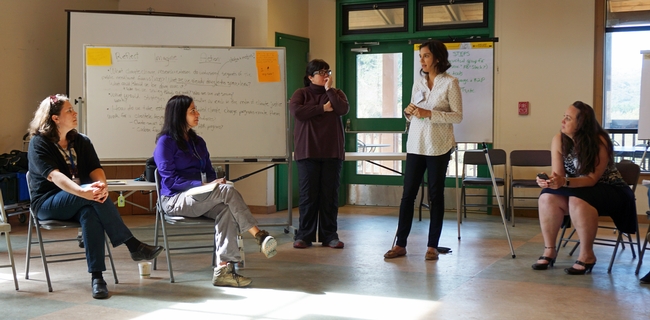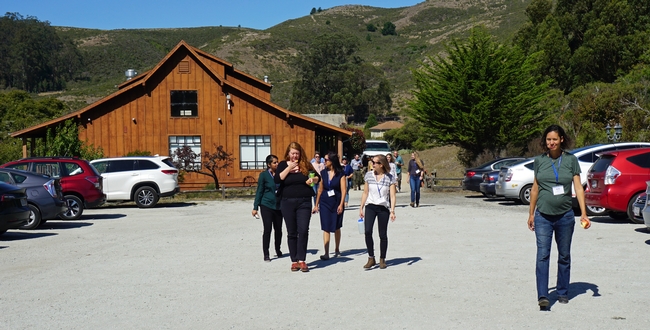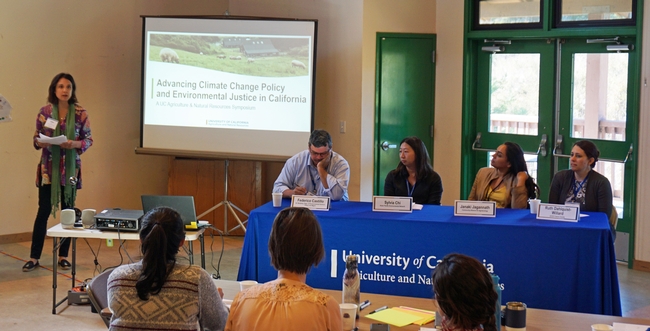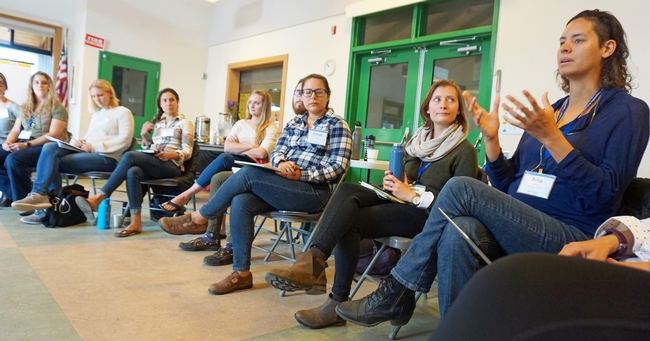For UC Cooperative Extension (UCCE), attention to climate change goes beyond an increase in severe wildfires, droughts, floods and heat in California, and their impact on natural resources, agriculture and the state's economy.
The program focuses on the health and resilience of people in California, particularly those most vulnerable to climate change – those who can't afford air conditioning, who work outside on farms and in construction, those who are already disadvantaged by a low income, racial inequity or advanced age.
“UCCE climate change efforts must account for people and communities that face socioeconomic and political barriers to prepare for, adapt to and recover from the effects of climate change,” said Clare Gupta, UCCE public policy specialist.
UCCE advisors, educators and specialists are working in their local communities across the state to prepare residents to adapt to the warming climate and make changes that will help reduce greenhouse gas emissions to make climate change less severe. They convened Oct. 7-8 at UCCE's Elkus Ranch Environmental Education Center in San Mateo County to learn about projects currently underway to confront the crisis, share resources for adaptation, identify future research and education needs, and add their voices to a growing chorus of experts speaking out to protect the future of planet earth.
“We are at a momentous time,” said Janaki Jagannath, a law school student and climate activist who spoke at the meeting. “California is waking up to environmental justice problems and climate change.”
The plight of underprivileged California residents at the forefront of climate change impacts became crystal clear to UCCE small farms advisor Ruth Dahlquist-Willard when she was hired during the state's devastating 2011-2016 drought.
In the summer of 2014, many small-scale family farms in the San Joaquin Valley saw their wells dry up due to dropping groundwater levels. Some Hmong farmers were calling suicide hotlines, in fear of losing their crops and livelihoods. Dahlquist-Willard said these farms, with shallower wells and limited resources to cope with the effects of drought, are more vulnerable to climate change.
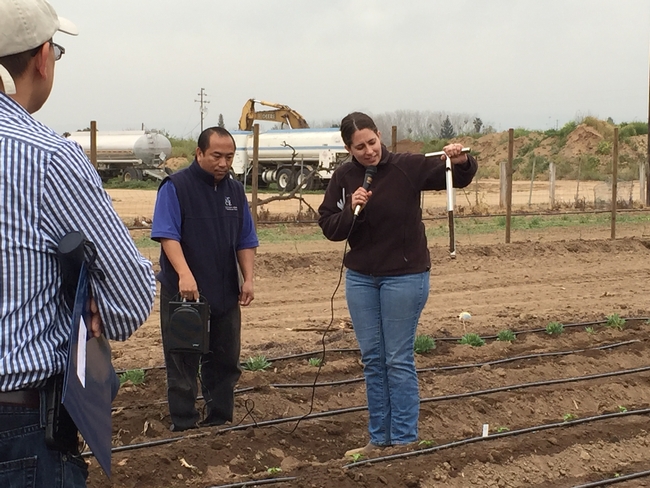
To help Hmong farmers and other small-scale farms prepare for the next drought, Dahlquist-Willard and her team began helping them with applications for the State Water Efficiency and Enhancement Program (SWEEP), which provides grants to improve irrigation systems. Improvements funded by SWEEP help farmers use less water and cut back on electricity for pumping.
So far, 38 Fresno and Tulare farmers have received SWEEP grants with technical assistance from Dahlquist-Willard's program, for a total of 878 acres.
The Sustainable Groundwater Management Act (SGMA), which goes into effect in 2020, also imperils small-scale farmers. The new law will limit both large-scale and small-scale farmers' ability to pump groundwater, however, small-scale farmers often are not in a position to influence the agencies that will be governing groundwater use.
“There will be competition for water under SGMA,” Dahlquist-Willard said. “Whether the small farms still have access to water depends on how the rules are set up.”
SGMA poses another threat to vulnerable rural community members. Experts predict the imposition of regulations on groundwater use is likely to put 500,000 to 1 million acres of California farmland out of production, reducing jobs for farmworkers and putting a strain on businesses in the rural communities where they live and shop.
The expected shift in crops grown in California due to climate change also potentially reduces income for workers who have specialized in specific crops, said Federico Castillo, UC Berkeley agricultural ecology professor.
“They work longer hours to compensate,” Castillo said. “Their income is impacted.”
On a recent trip to Huron, a San Joaquin Valley city with highest proportion of Latino residents in the U.S., Castillo said he passed by vast solar farms that now cover formerly productive farmland.
“Solar farms are a benefit for society, but there are not local benefits. The problem is, this displaces farmworkers,” he said. “We have to think hard about economic policy. This is just one example. There are many others.”
In addition to the threat climate change poses to their employment, farmworkers are particularly susceptible to the warming temperatures the world faces. Castillo is studying the potential impact of weather extremes on people who do the planting, weeding, irrigating, pruning and harvesting that makes California's $50 billion annual agricultural output possible.
“Heat and humidity impacts ag workers negatively,” Castillo said. “It impacts the heart, liver and kidneys.”
What's more, many farmworkers don't have health insurance and don't visit medical doctors. Some, particularly those who hail from the Mexican state of Oaxaca, Castillo said, rely on home remedies, putting their health at still greater risk.
Sylvia Chi, policy director with the Asian Pacific Environmental Network, spoke about her constituency's concern about the future.
“How do we deal with labor market displacement from phasing out fossil fuels?” she asked. “We need to transition all communities.”
Transition in farming
A large part of UC Cooperative Extension research and extension targets the agricultural industry, which joins other industries in emitting greenhouse gases into the atmosphere, resulting in our warming climate. A key part of mitigation is tied in new brands of farming that aim to address these issues: climate-smart, emergent, sustainable, regenerative and conservation farming.
A component of all these farming philosophies is soil health. Improving soil health traps more carbon underground, where it can't immediately escape into the atmosphere and contribute to increasing warming. Improving soil health has co-benefits, such as improving soil fertility, water infiltration and yield.
The CDFA Healthy Soils grant program offers financial incentives to eligible farmers for implementing soil-building practices. CDFA provided UC Agriculture and Natural Resources (UC ANR), UCCE's parent organization, with $1 million to hire climate-smart educators to provide technical assistance to farmers applying for Healthy Soils and SWEEP grants to improve their irrigation systems, plant cover crops, eliminate or reduce tilling, and implement other practices. A target in their effort is helping underprivileged farmers determine eligibility and navigate the complicated application process.
UC ANR hired nine community education specialists, who are now working with farmers in Mendocino, Merced, Glenn, Yolo, Solano, Sacramento, Santa Cruz, Kern, Ventura, San Diego and Imperial counties. Their contributions to farmers in those areas go beyond the grant applications and reach farmers that can't take advantage of CDFA grant programs.
“Because this is a new program, we have the luxury of helping figure out our role,” said Britta Baskerville, the community education specialist in Mendocino County. “We're all coming up with ways to educate farmers in climate-smart practices.”
Climate change resilience
The UC ANR Infomatics and GIS Program is supporting climate change resilience by creating an online networking platform for local governments, such as city councils and boards of supervisors, to empower their communities' resiliency efforts. Called the California Resiliency Alliance, the resources include case studies, planning guides, incident maps, and weather watches, warnings and advisories, plus a platform for sharing information across public-private sectors and across industry sectors.
IGIS is also involved is gathering peer-reviewed data sets for downscale climate projections. UC Berkeley Ph.D. student Lucy Andrews is conducting interviews to identify climate needs and social vulnerability information. The information will make the state's Cal-Adapt website, the primary repository of knowledge about the California climate of the future, an even more useful tool.
“Our strategy is to make climate data accessible,” said Andy Lyons, IGIS statewide program coordinator. “People can get climate data and decision support tailored to specific audiences.”
Diversity in the UC California Naturalist program
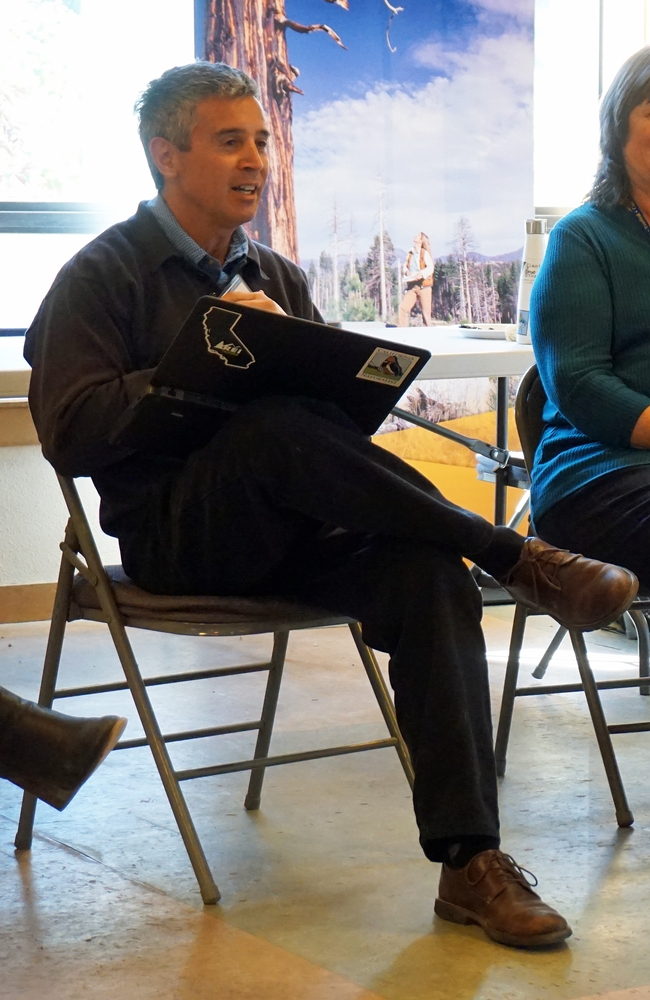
California Naturalist's new Climate Stewards Initiative, which will provide training to extend information about climate change mitigation, resilience and adaptation, is being created with diversity, inclusion and equity woven in from the outset. Trainees will learn about psychology, sociological and cognitive sciences, in addition to the hard sciences that touch climate change – meteorology, physics, natural resource management and biology.
“The certified climate stewards will be able to communicate and work with others as to how climate change will affect them. It will be an ongoing social learning community that provides a transition from a sense of helplessness to a sense of empowerment,” said Sarah-Mae Nelson, the UC Climate Stewards Initiative academic coordinator.
Traditional CalNat certification courses are provided fully in-person and partially outdoors. Climate Stewards training will be available in a hybrid online/in-person format to increase the course's availability to a wider circle of community members.
“The flexibility will increase accessibility,” Nelson said.
(Published Oct. 17, 2019)
